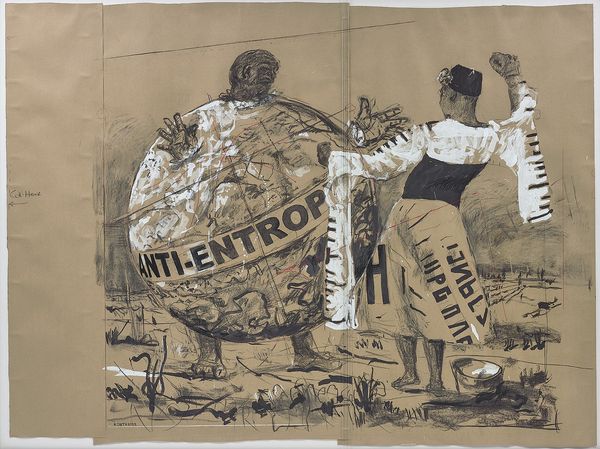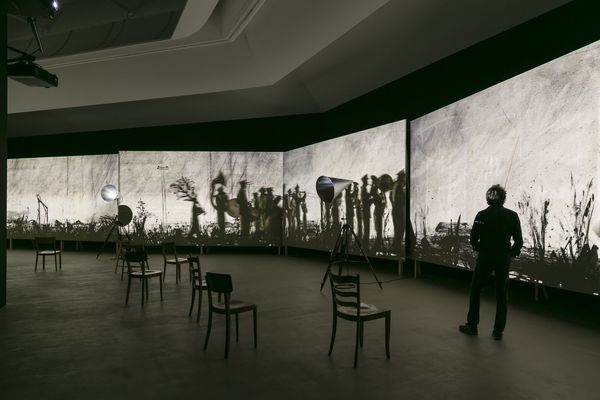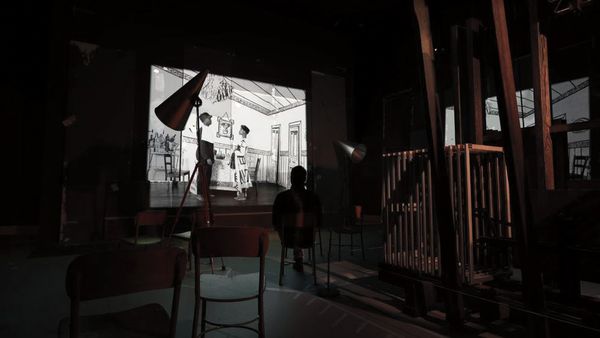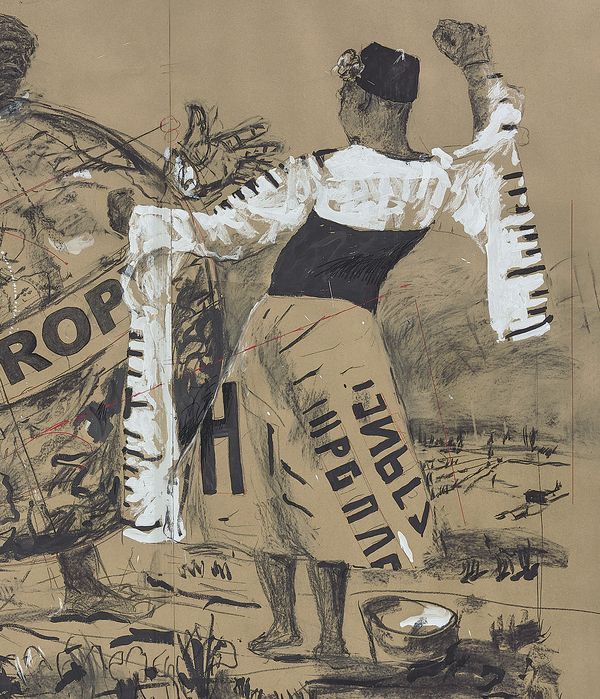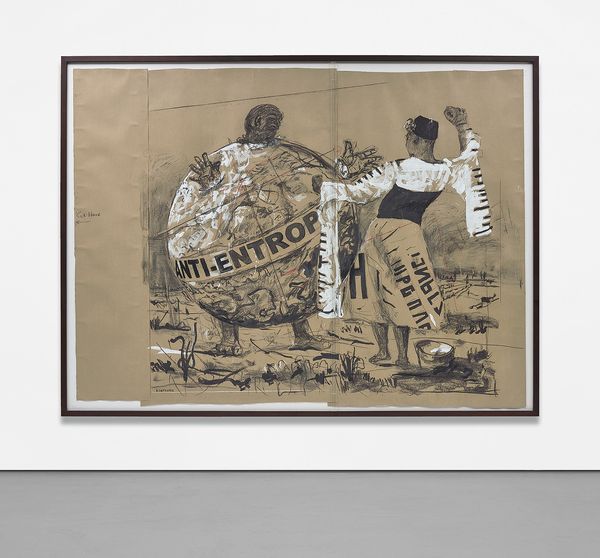William Kentridge Anti-Entropy, 2011
William Kentridge, More Sweetly Play the Dance, 2015, 8 channel HD video, 15 minutes duration, installation view at Kunstmuseum Basel. Image © Kunstmuseum Basel | Gegenwart, Photo: Julian Salinas. © William Kentridge; courtesy of the artist and Goodman Gallery.
Exploring and championing a breadth of mediums, such as animation, collage, performance and drawing, William Kentridge’s complex creations are multifaceted in form, resonating with audiences through their unifying exploration of the very fabric of our existence. Drawing on Richard Wagner’s notion of the ‘Gesamtkunstwerk’, Kentridge’s sensory microcosms toy with the layering of multiple meanings. Revisiting and reacting to philosophical, historical or political tropes, Kentridge conjures myriad themes in his polymorphic works, producing works on paper and videos which are both experimental, structurally fragmented and conceptually rich. This multifaceted approach is explored in Kentridge's solo show, A Poem That Is Not Our Own, currently on view at the Kunstmuseum Basel, which explicitly delineates the multiple points of connection between drawing and filmmaking in the artist's oeuvre. Kentridge even coined a unique term, "poor man's animation," to describe his style of using photographs of charcoal drawings to create short films.
William Kentridge, The Refusal of Time, 2012, The Metropolitan Museum of Art, New York. Image © The Metropolitan Museum of Art / Art Resource, NY, Artwork. © William Kentridge; courtesy of the artist and Goodman Gallery.
Utilizing charcoal, colored pencil and paint on paper in the present work, Anti-Entropy, executed in 2011, invokes a key image from the Kentridge’s Anti-Mercator video piece, a work created in preparation for the artist’s project The Refusal of Time at Documenta 13 in Kassel, 2012, later shown at Louisiana Museum of Modern Art, Humlebaek, with a version jointly purchased by The Metropolitan Museum of Art, New York, and the San Francisco Museum of Modern Art. This immersive work explored the technology of time-keeping and string theory, created in dialogue with physicist Peter Galison, while the earlier preparatory Anti-Mercator work explored the suspension of time and the resistance of spatial and formal linearity presented by scientists such as Gerardus Mercator. Together, this body of work by Kentridge explores time and our changing cultural and standardized perceptions of time and space.
Detail from William Kentridge's Anti-Entropy, 2011
Breaking away from a linear presentation, Kentridge’s films present images that become increasingly incomplete, as if erased; in Anti-Mercator the artist runs the film backwards so that the drawings diminish within the film rather than flourish. Comprised of three parts of brown pattern-makers paper, Anti-Entropy presents the monumental formalization and expansion of the video’s principal image. Highlighting the importance of narrative and movement in his oeuvre, Kentridge’s works on paper incorporate the artist’s experimentation with stratifying and layering, culminating on paper through fragmented, part-intelligible vignettes, made with thin washes of paint and sheer veils of graphite, which suggest an upcoming chapter or installment.
Eadweard Muybridge Dancing Woman, plate 187 from Animal Locomotion, 1887. Image: Bridgeman Images.
In the present work, Kentridge evidently extols in the medium of drawing; through laying bare erasures, smudges and altered forms, as well as exposing the work’s multiple compositional recesses, he allows the viewer to animate the scene, bringing the dancing pair to life. Deploying a filmic sequence or an image captured in motion, as evident in the work of Eadweard Muybridge, Anti-Entropy extends its purely formal dimension to the conceptual. Weaving the caption 'Anti-Entropy' across what seems to be a costume-globe, worn by a figure engaged with another graphically adorned dancing figure, the composition alludes to a theme Kentridge returned to time and again in his oeuvre. Anti-Entropy, in his terms, could be defined as an act of resistance: a fortified will. As specified by the artist, ‘One way of describing what makes something alive is that it resists the tendency to cool down, lose energy, to go from one state of order to disorder, for the human body to turn to dust. It is anti-entropic. So, when we throw a jug up in the air and it shatters, entropy declares statistically how unlikely it is that if we throw those shards into the air they will land back into the form of that same jug. But if you take all the shards that have been shattered, the artist's job is to construct these shards, if not into the first jug, then into another jug. To describe another understanding of the world is an act of resisting entropy’ (the artist, quoted in Keli-Safia Maksud, ‘William Kentridge in Conversation’, Ocula Magazine).
Installation view of William Kentridge's Anti-Entropy, 2011
In Anti-Entropy, a sense of performativity is also made evident. The work’s open and dynamically sketched appearance defies the static nature of two-dimensional compositions. The act of drawing itself can be an almost liberating and anti-entropic gesture; notably Kentridge’s desire to materialize unending movement in the present work seems to echo his fervent desire to utilize theatrical or expressionist language to convey motion and emotion in his narrative-driven works. Constantly rethinking the boundaries of drawing and two-dimensionality, the artist expands his creations beyond the confines of their medium, thereby challenging the static nature they inherently suggest. Boasting gigantic scale, dramatic contrast, and projecting images on blank space as he would characters on a stage, the artist ceaselessly works with theatrics that exude an arresting sense of resonance through their form, content and context.
